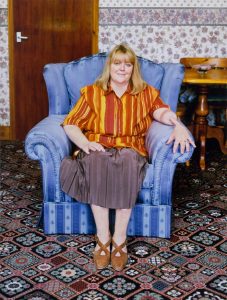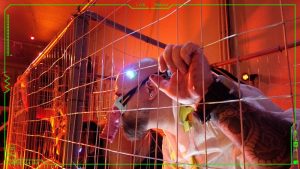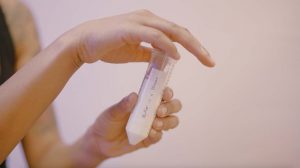A phantom limb is the sensation that an amputated or missing limb (even an organ) is still attached to the body and is moving along with the rest of the body. Phantom Recorder, a project developed by designer Revital Cohen together with a team of scientists for the Impact! exhibition, explores the phenomenon and asks As strategies for repair focus on practical solutions, they tend to overlook poetic functions of our body, but what if one could record and keep their phantom sensation, to be awoken on request?
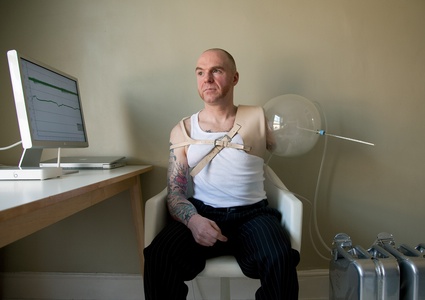 Image courtesy of the designer
Image courtesy of the designer
The Phantom Recorder system projects a cold and damp sensation onto the skin surface, triggering the brain to hallucinate a phantom. As the phantom movement stimulates the peripheral nerves, its activity is captured and recorded by a neural implant and external wireless machinery. When the prosthetic has been fitted, digital data of the recorded phantom sensation can be transmitted to the implant, allowing the nerves to recreate the sensation of the telescoped phantom hand, the severed feet or the split arm.
Like i guess most of you i wanted to know more about Revital’s project so i asked her a couple of questions:
You worked together with a team of researchers to develop the concept of Phantom Recorder. How did the working process start? Did you come up with an idea and the organizers of Impact! put you in touch with the scientists that might be able to help you? Or was the scenario totally different?
Normally, that is how I would work but in this case it was exactly the opposite. Impact! was a collaborative project between the EPSRC (Engineering and Physical Science Research Council) and the RCA’s Design Interactions department. I was one of 15 graduates, students and staff who were requested to use design in order to explore the impacts, implications and possibilities created by an epsrc funded research.
I chose to work with the team at the Cambridge Centre for Brain Repair as their implant – an apparatus that will function as an interface between computer and the nervous system – absolutely fascinated me. It seemed related to my interest in the tensions and intersections between man and machine, an area I have been exploring for a while. After meeting members of the team in both the nano technology and tissue engineering laboratories, I started looking at ways in which this technology of repair might make us use and perceive our bodies differently.
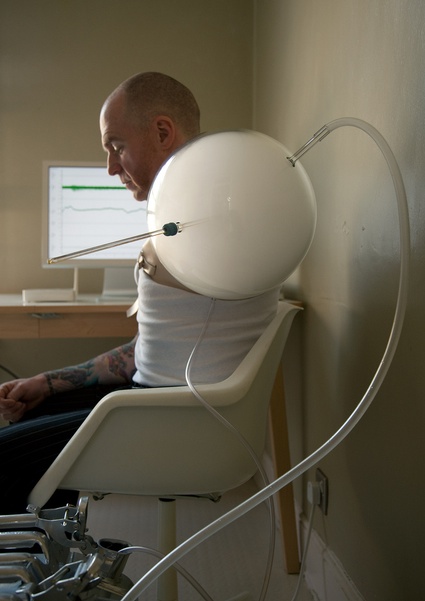 Image courtesy of the designer
Image courtesy of the designer
I was immediately interested by your project because it focuses on phantom limbs, a phenomenon i discovered the first time i saw the work of Alexa Wright. Where does your interest for phantom limbs come from?
The project was quite limb-focused from the start, as the implant is made to regenerate the peripheral nervous system. However, while the science team are working on finding ways to record and transmit action to prosthetic limbs, I started wondering whether we could take such a functional technology and apply it to capture an invisible organ, to catch a ghost. I got intrigued and hugely inspired by V.S. Ramachandran’s book Phantoms in the Brain: Probing the Mysteries of the Human Mind, which looks into neurology in order to really open the definition of physical experience. In particular, I was drawn to the unique hyperabilities of some of these deeply personal, uncanny, hallucinated organs; from telescopic hands to orgasmic feet.
To me, Phantom sensations can be read as poetic functions of the body, the brain holding on to the memory of the limb which is missing (or was never there). Free of physical limitations, often disobedient, they defy our expectations from our body to function according to a utilitarian logic. More so, these sensations blur the boundaries between the body and mind, shifting our perceptions of the way we are networked, I mean, what if our imagination could be captured through the nerve endings in the shoulder?
Phantoms extend one’s sense of self beyond the body, and are therefore a strong trigger for interpretations of the human condition, Lord Nelson even claimed his phantom pain was a “direct evidence for the existence of the soul”.
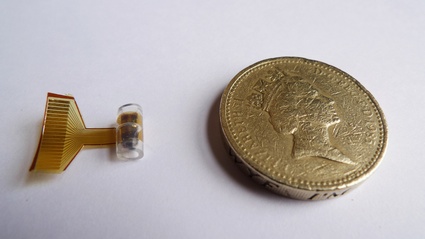 Image courtesy of the designer
Image courtesy of the designer
The prototype you designed has a very dramatic aesthetics. Could you describe how it would work and what it would be made of?
The implant, as developed by the research team, is tiny and would be invisibly implanted into the limb. However it will be able to record and send signals from and to the peripheral nerves through any computer. As phantom sensations often disappear with time, I saw in this implant the opportunity to catch and archive the sensation as digital data that could then be replayed, cherished or shared.
My prototype was designed as a sensory catalyst to trigger the nerves into activating the phantom for the moment of recording. The Phantom Recorder system is made of a glass dome containing a controlled micro-climate of cool mist. Since phantoms are often responsive to cold weather, when worn the sphere projects a cold and damp sensation onto the skin surface, triggering the brain to hallucinate a phantom. As the phantom movement stimulates the peripheral nerves, its activity is captured by the neural implant and external wireless machinery. When the prosthetic has been fitted, digital data of the recorded phantom sensation can be transmitted to the implant, allowing the nerves to recreate the sensation of the invisible organ.
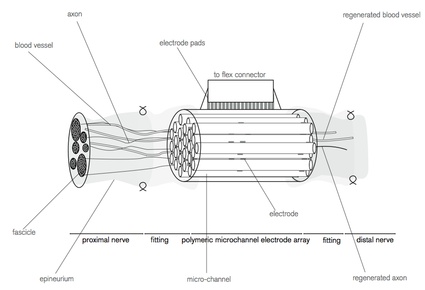 Did you get the opportunity to discuss people who had lost a limb about your project? How did they react to the Phantom Recorder?
Did you get the opportunity to discuss people who had lost a limb about your project? How did they react to the Phantom Recorder?
Yes, I had many conversations about it throughout the design and fitting process with the actor wearing the object in the photoshoot. Nick used to suffer from phantom pain and I was worried it might return while we were shooting, but he was enthusiastic about the project and was keen to do it either way. Apparently there is quite a distinct demographic for people who experience a phantom, as I was told on my first meeting with the scientists, since the majority of amputees are young men who lost their limbs either in the military or in various acts of daredevilry. So in a way it is an experience which often correlates with a certain sense of adventure, audacity and high levels of endurance.
And indeed, after all the build up towards the day, with the constant talk about phantoms during those weeks, Nick’s phantom sensation – which has been gone for years – was suddenly awaken the night before (he still thought it was worth it).
Thanks Revital!
Previous work by Revital Cohen: Life Support – Could animals be transformed into medical devices?

